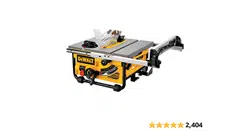Loading ...
Loading ...
Loading ...

inalignmentwiththesawbladeandtheanti-kickbackassemblymuststopakickback
onceithasstarted.Checktheiractionbeforerippingbypushingthewoodunderthe
anti-kickbackassembly.Theteethmustpreventthewoodfrombeingpulledtowardthe
frontofthesaw.
d. Plasticandcomposite(likehardboard)materialsmaybecutonyoursaw.However,
sincetheseareusuallyquitehardandslippery,theanti-kickbackpawlsmaynotstop
a kickback.Therefore,beespeciallyattentivetofollowingpropersetupandcutting
proceduresforripping.
e. Usesawbladeguardassembly,anti-kickbackassemblyandrivingknifeforevery
operationforwhichitcanbeused,includingallthrough-sawing.
f. Pushtheworkpiecepastthesawbladepriortorelease.
g. NEVERripaworkpiecethatis twistedorwarped,ordoesnothavea straightedgeto
guidealongthefence.
h. NEVERsawalargeworkpiecethatcannotbecontrolled.
L NEVERusethefenceasaguideorlengthstopwhencrosscutting.
j. NEVERsawaworkpiecewithlooseknots,flaws,nailsorotherforeignobjects.
k. NEVERripaworkpieceshorterthan10"(254mm).
L NEVERuseadullblade- replace or have resharpened.
_&WARNING: Some dust created by power sanding, sawing, grinding, drilling, and other
construction activities contains chemicals known to the State of California to cause cancer,
birth defects or other reproductive harm. Some examples of these chemicals are:
• lead from lead-based paints,
• crystalline silica from bricks and cement and other masonry products, and
• arsenic and chromium from chemically-treated lumber (CCA).
Your risk from these exposures varies, depending on how often you do this type of work.
To reduce your exposure to these chemicals: work in a well-ventilated area, and work with
approved safety equipment, such as those dust masks that are specially designed to filter
out microscopic particles.
• Avoid prolonged contact with dust from power sanding, sawing, grinding, drilling
and other construction activities. Wear protective clothing and wash exposed
areas with soap and water. Allowing dust to get into your mouth, eyes or lay on the
skin may promote absorption of harmful chemicals.
_WARNING: Use of this tool can generate and/or disburse dust, which may cause
serious and permanent respiratory or other injury. Always use NIOSH/OSHA approved
respiratory protection appropriate for the dust exposure. Direct particles away from face
and body. Always operate tool in well-ventilated area and provide for proper dust removal
Use dust collection system wherever possible.
SAVE THESE INSTRUCTIONS
FOR FUTURE USE
Specifications
Amperes 15 A
Miter Angle 60 ° L and R
Bevel Angle 0° to 45° L
Blade Size 10" (254 mm)
Max. Cut Depth 0° Bevel 3-1/8" (79 mm)
Max. Cut Depth 45 ° Bevel 2-1/4" (57 mm)
RPM, no load 3850
Unpackmg
AWARNING: Toreduce the risk of injury, DO NOT connect the machine to the power source
until the table saw is completely assembled and you read the entire instruction manual
Open the box and slide the saw out, as shown in Figure 1. Carefully unpack the table saw
and all loose items from the carton. Examine all parts to make sure that parts have not
been damaged during shipping. If any parts are missing or damaged, contact your dealer to
replace them before attempting to assemble the tool.
Refer to Figure 2 for the loose items and hardware included with the saw:
1. Rip fence
2. Arbor wrench and spindle wrench (attached to saw base)
3. Blade guard assembly
4. Miter gauge
5. Push stick (attached to rip fence)
i_WARNING: To reduce the risk of serious personal injury, have push stick ready to
use before starting cut.
FIG. 1 FIG. 2 5
FEATURES (Fig. 3, 4)
Examine Figures 3 and 4 to become familiar with the saw and its various parts.The following
sections on assembly and adjustments will refer to these terms and you must know what
and where the parts are.
FIG. 3 C B D
Q L E
K N
Loading ...
Loading ...
Loading ...
